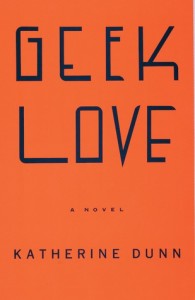Dunn, Katherine. (1983/2002). Geek Love. New York: Vintage (348 pp).
You have to give this novel credit for sheer originality. The main characters are a U.S. family of performers in a traveling carnival, in the recent past. All the children are physically deformed in some way and constitute what used to be called the “freak show.”
The main character and first-person narrator is a bald albino dwarf with a hunchback. There is a set of “Siamese” twins – two heads, four arms, and one body from the waist down. The oldest child is a sort of white, hairless creature with flippers for limbs. Mom and Dad are insane, of course, and drink anything from kerosene to insecticide, trying to produce more deformed offspring.
In the course of the novel, which describes the ups and downs of the circus, as well as relatively ordinary family dynamics – jealousies, favoritism, competition, resentments, and so on, the reader has full opportunity to explore physical deformity. No need to avert your eyes in embarrassment or disgust.
You can find out what it would be like to have sex with Siamese twins, and what they would think about it. You can know what it’s like to have a hump on your back and what it would feel like to stroke one. You can learn what it would be like to be a fishlike, maggot-like torso-person. No prurient interest denied! All conceivable body products, functions, and orifices are described in detail. Step right up! Find out what it’s like to be constantly stared at, to be regarded with revulsion by the “norms” (normal people). Hurry, hurry, hurry!
The author goes to considerable effort to shock, disgust, and horrify the reader with this exploration of physical deformity, sacrificing plausibility to do so, with gory surgeries, multiple amputations, incest, murder, artificial insemination, even religion and cultism. The narrative and the characters are so far over the top that I’d characterize the novel as comedy rather than horror. For me, it was sometimes funny, never horrifying, and never even slightly believable; merely imaginative.
Why then is the novel so popular (finalist for the National Book Award) and widely praised? My speculation is that it appeals mainly to teenagers and pre-teens, for whom the body is the greatest secret – and to adults who still think like that. Each person believes they ARE the body and that their own body is uniquely special and secret, a source of pride and shame, delight and disgust. Young people believe that intimacy means exposing your body to another person, and that the main differences between people are their bodies. I fear that this is the mentality of most adult “norms” as well, and the reason most people have such a fascination and revulsion for someone who is severely physically deformed. And it is the reason they would like this book.
Beneath those childish, unexamined attitudes towards one’s body, there is the undercurrent of sexuality. Sex is physical, bodily activity, and since having sex is taboo in decent society, then fascination with deformity is a displacement of fascination about sex. How do freaks have sex, that’s what we want to know, isn’t it? And if you’re physically deformed, then the values of lookism automatically disqualify you from sexual competition, and what a horror that would be, right? And in that case, your self-esteem would have to be in the toilet, except in this novel, the “freaks” take great pride in their “uniqueness” and have nothing but contempt for the norms. They form a family, a tribe, a cult.
One important character believes that any woman who is sexually attractive is doomed to a life obsessed with the body because society will demand it (not far from the truth), so out of compassion, she works to disfigure such women so they can drop out of the sexual rat race and make something significant of themselves.
There are some interesting variations on these themes, such as having one child in the family who is physically normal but psychologically abnormal (he has telekinesis, but no sense of self). There is a minor but important character who is normal, even beautiful, except for her bushy tail, which she is urged to amputate.
However, this isn’t a book about the psychology of embodiment. It’s a novel and its aim is to titillate, horrify and amuse, so none of the deeper themes is well-explored. As a silly, implausible, thinly sketched, slightly repetitive, and ultimately sentimental story, it’s not very enjoyable. If you are confused about the meaning of embodiment, you’ll find it emotionally stimulating. But either way, you’ll remember this book.

